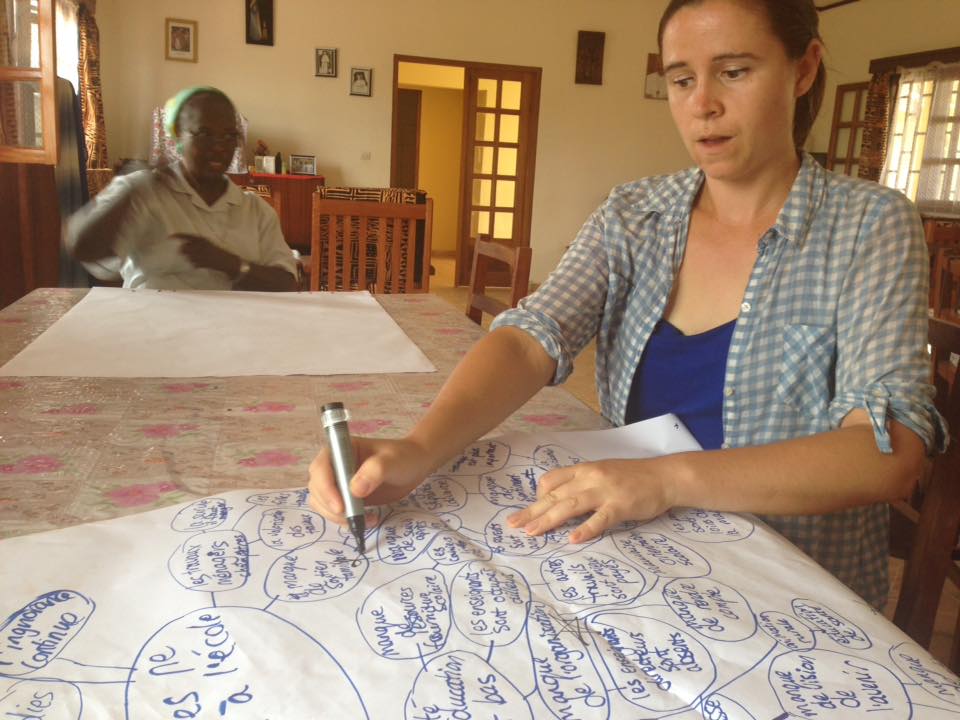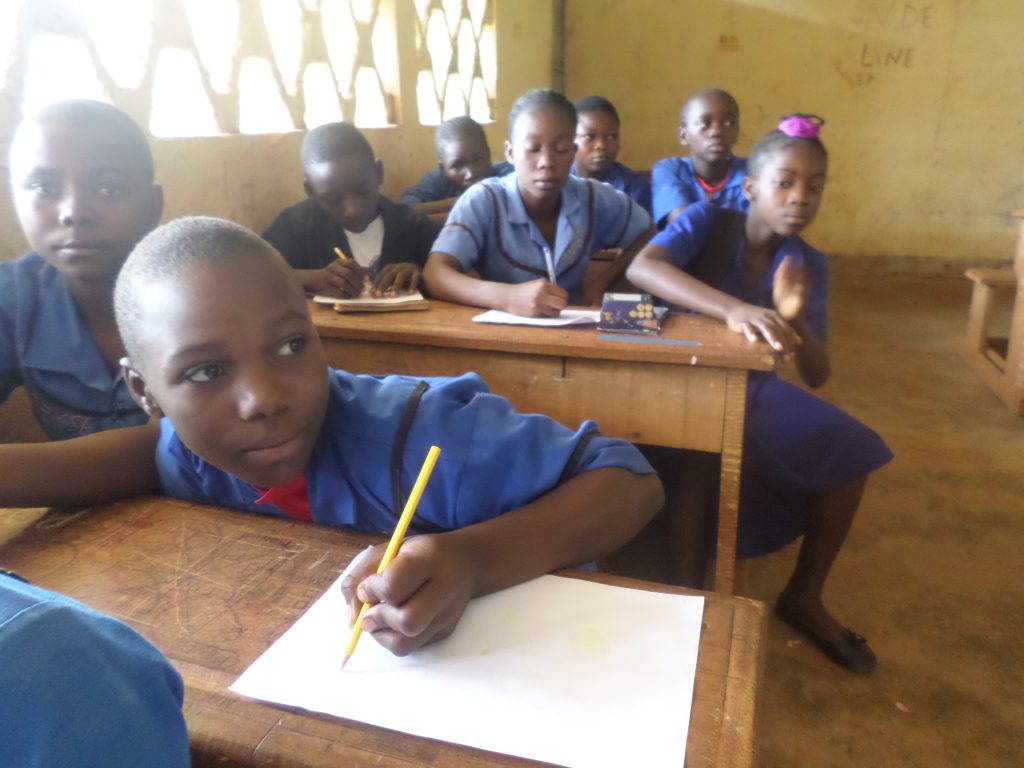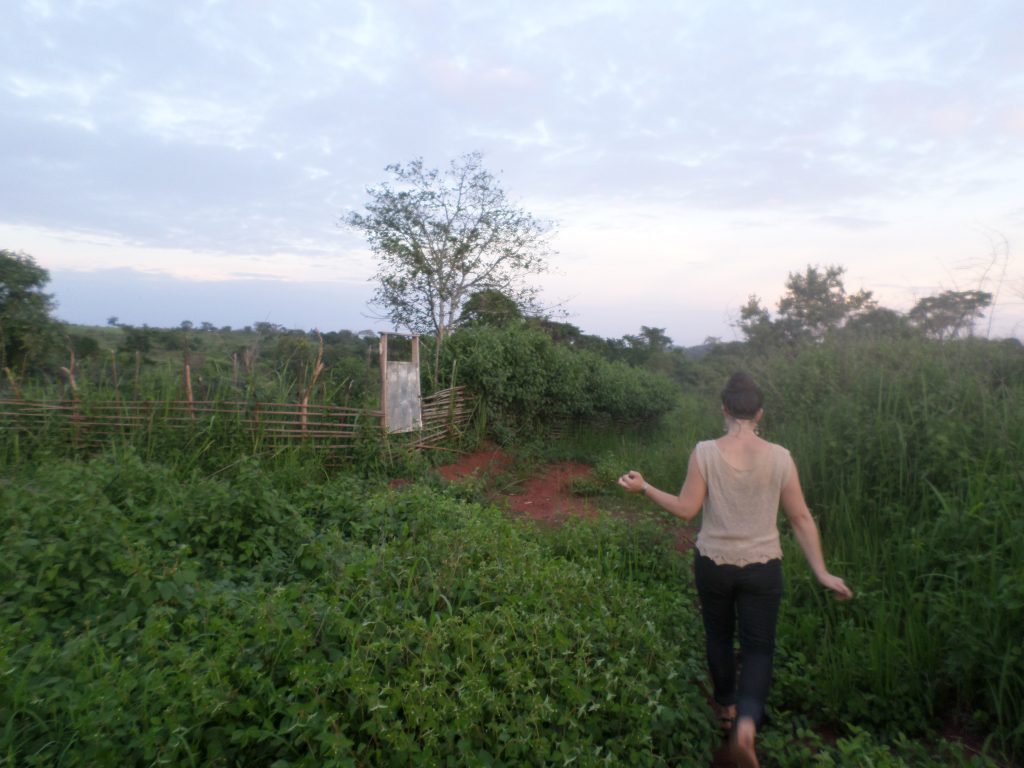
Working with Sister Collette on designing a school program in Gadji, East Region of Cameroon – photo courtesy Janet Fofang
“We made it!” Janet shouted, as arms and legs became more entangled and thrown in every direction as all of us passengers attempted to crawl out of the dusty car with a burning desire to breathe. I looked around for something familiar about Gadji, that would remind me of Bafia, but I couldn’t see it. Tall slender men, wandering around in long shiny robes with nice caps, boys chasing cattle down the road. The massive fire pits of beef grilling sent waves of mouthwatering smoke, and the majority of children on the road were attempting to sell milk to anyone they deemed might be slightly interested in buying. Even the mosque seemed rather foreign, makeshift due to its “under construction” status, yet obviously well-loved and soon to be well-used. At this point, I wasn’t even sure I was in Cameroon, since the outfits, the language, and houses were new to me. But then I saw Megan, my fellow volunteer friend, easily spotted sticking out as a sore thumb, buying us bottled water at the local boutique on the side of the road, welcoming us to her village in the East. At least she was something I knew, and she was so at ease and so natural as she spoke fluent Fulfulde to the children around her smiling and nodding.
Janet and I had first talked about traveling to the East when a friend of hers, a Catholic nun in Gadji, had asked for help in designing a school. As she and I discussed the project, it was by pure chance that these contacts of hers lived in the same village and even knew my friend from my training group in Peace Corps. We started planning our trip, knowing that Gadji would be out of our range of understanding, being in the “remote” and “wild” part of the country. I was excited that for the first time I could try out a community needs assessment in a new place within a limited time frame, a common international practice that I had learned in grad school. The idea of collecting data and helping a “client” design a project, however informal the circumstances, made me stay up at night wondering how much we could really discover and how much data we could collect in just a few days.
Those few days in Gadji were such a blur, rushing forward at lightning speed, attempting to talk to anyone and everyone, working with students, trying out tools with the sisters, observing the women’s cooperative at work. Everywhere we went, I attempted to listen, recollect, and then sit down and note everything I could remember as soon as I found a quiet secluded corner. Meanwhile Janet wandered around photographing anything and everything, talking to people as we went by, or trying to, since many didn’t speak a word of French or English. Megan bravely acted as our guide, attempting to explain to her friends and community why these two foreigners were here, and why they were asking odd questions and photographing everything as if they were some sort of crazy news journalists, or perhaps international spies here to take over their village. People wavered, unsure what to think of us as we walked through their town, but they seemed to look slightly more assured as they saw Megan’s familiar face and greetings, whether it was in Fulfulde or in Kako.

Students sharing with us about their community, CES Gadji
By the time the day had ended, Megan, Janet, the two Sisters and I were comfortably settled around the dinner table with full stomachs at the convent, talking about Gadji and its myriad of complexities by candlelight. Although Janet and I had only scratched the surface, we had already learned a few things about Gadji:
- There are two major groups in Gadji, the Kakos and Fulbes (This is of course excluding the up to 3,000 refugees from the CAR in a nearby refugee camp, which we didn’t visit). Kakos are the original inhabitants of the area and are farmers, and the Fulbes were nomadic at some point, but now live permanently in the village and herd and sell cattle. The Kakos are predominantly Christian, and the Fulbes are almost exclusively Muslim, and the lifestyle, the way they dress, and their houses are quite contrasted in which it was pretty easy to see who was who. Nevertheless Megan and everyone we met reassured us that the groups live together in peace and harmony.
- Food is a problem for everyone – whether it’s diversity of crops, or selling products to make a reasonable income, people in Gadji struggle. When there’s less food on the table, and less money in the pockets, less kids can go to school, as was shown by the number of empty desks found at Gadji’s only middle school (there is no high school), where the female dropout rate is alarmingly high.
- Girls struggle a lot here. Cultural norms dictate that many women, especially Fulbe women, should stay at home, get married young, and not go to school.
That evening we were finally able to digest, analyze, break apart, reconstruct, and organize all of our ideas, thoughts, and frustrations about the day through conversation. One of us would throw a problem out on the table to challenge us, and the rest of us would tackle it, proposing hundreds of projects that we had created in our minds, a million more left unspoken. There was no rhyme or reason to why Gadji was the way it was. It was just unique and special, a place that we all appreciated, but knew at different levels.
In the end, after another long day of working with students, we finally had to leave, our heads exploding with so many thoughts and ideas. What struck me at lunch was the realization that as we spoke, we all had such different visions of the community and the people who live there, some positive, some negative. As I appreciated my delicious nutritious meal, I came to a realization that none of us were from Gadji, and that for this reason we struggled to understand what must have seemed obvious to those in the community that we had talked to today.
I left with an odd feeling in my stomach, as if I had been cheated out of the real story, which I didn’t deserve anyway since I hadn’t taken the time to respect and appreciate the culture. I could only take comfort in the fact that even if I couldn’t “figure out Gadji,” that at least Megan had, by some way or another integrated herself at post to trust and know those around her, and was kind enough to share this precious insight with us. I left her pouring herself over a picture I’d made her draw: a symbolic artistic representation of her perspective of Gadji. She sat there in the room like she had the night before by candlelight, drawing the intricate details of hands that all grabbed for the same leaf in a pool of water. Although I couldn’t quite grasp the details, the emotions that she tried desperately to share were slightly clearer. Everyone in Gadji, regardless of background, shared the same life and essence, and were reaching for it together to live. And that was all I could ever dream of knowing.

Megan enjoying an evening in Gadji


I am here to know that can do you guys know from where I can learn about ghostwriters for hire uk as you guys are talking about it so I though may be you guys know about them, the thing is that I am looking to run my business in this and in this period of time I need to learn about it so much as I can so that I will be able to get more and more information which help me in my business.
Great